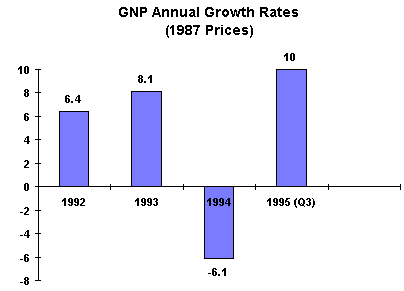| In
the latter part of the 1980s, due to overheating in economic
activity, difficulties were observed in terms of growing fiscal
deficits and rising inflation. These problems became especially
evident in 1993 with the trade deficit reaching $14.1 billion US.
The negative impact of the
developments which took place in the financial markets at the end of
January, 1994 also began to be felt throughout the real economy.
Volatility in the foreign exchange markets increased, interest rates
rose, the credit market stagnated, and unanticipated inventory
build-up accompanied the contraction in domestic demand.
In April, 1994 the Government
introduced a Stabilization and Structural Adjustment Program
designed to correct the macro-imbalances in the economy and
re-establish the conditions for sustainable growth. In addition to
this, the Government initiated consultation meetings with the IMF.
After reaching full agreement on the program with the IMF, a
Stand-by Arrangement in the amount of SDR 509 million to support the
Government Stabilization Program was approved by the Executive Board
of the IMF on July 8, 1994. The core of the Stabilization Program
consists of a set of strong measures to reduce the public sector
deficit. This fiscal retrenchment is supported by a restrained
monetary and credit policy, the elimination of the practice of
backward indexation in income policies and by appropriate foreign
exchange and interest rate policies.
Economic indicators of Turkey
Geographical area
Population |
774,815 sq kms
61,183,000 |
GNP(1994, at
current prices)
Per Capita Income |
TL 3,887,903
billion
US$ 2184 (1994) |
GDP Composition by
Sectors(%) 1995-Provisional(Q3)
Industry |
26.3 |
Agriculture
Services |
20.0
53.7 |
Wholesale price
index (November 1995)
Interest rate on deposits average (September 1995) |
71.6%
86.51% |
| Exchange rate |
US $1= TL 63,287(
February 1996) |
Real GNP(at producers' prices), which
grew by 8.1 percent in 1993, slowed down to 4.1 percent in the first
quarter and contracted by 9.7 percent, 8.7 percent and 6.9 percent
in the second, third and fourth quarters of 1994, respectively.
However, according to recent figures,
under the Stabilization Program, real GNP contracted by 6.1 percent
in 1994. On the other hand, due to the favourable environment
created by the implementation of the Stabilization Program, real GNP
growth rate was realized 10.0% in the third quarter of 1995.
Moreover, parallel to the increase in economic activity, capacity
utilization, especially in the private sector, is expected to reach
its high 1993 level.

Source: State Institute of Statistics
Q3 : The new series in producers' prices
The measures taken up under the
Stabilization Program were successful in restoring stability in the
financial markets and decreasing interest rates to acceptable
levels. The increase in the supply of foreign exchange enhanced
stability in the foreign exchange market. Reserves picked up and
confidence in the system was restored.
The economic recovery and higher real
growth envisaged for 1995 is expected to affect trade performance
positively. The far-reaching stabilization package has been reaping
fruits as far as the measures on the balance of payments are
concerned. Prior to the stabilization package, the foreign trade
deficit and the resultant current-account deficit had both reached
an alarming level. According to recent figures, it seems that this
trend has been reversed. Turkey's current account surplus totaled
$2.631 billion US in 1994, an all -time high in the history of the
Republic. In the first ten months of 1995, exports reached $17.2
billion US, imports reached $27.8 billion US with a realized
negative trade balance of $10.6 billion US.
As of December, 1994, the annual
Consumer Price Index increase was 125.5 percent. As of the end of
November, 1995, CPI increase was 83.8%. The rate of inflation
measured in terms of the GNP deflator is expected to decrease to
79.4 percent in 1995.
Upon the formation of political
consensus on the need for privatization, the new Privatization Law
was enacted in November, 1994. Looking towards 1995, the new law is
anticipated to facilitate the sale of the telecommunication section
of PTT, the electricity and maritime enterprises. A privatization
revenue of $654 million US was realized in 1994. In 1995,
privatization sales of an expected $5.0 billion US are likely to
generate a cash inflow of 2.4 billion, which corresponds to a 1.7
percent share in GNP.
On March 5, 1995, Turkey and the
European Foreign Ministers decided to implement the final phase of
the Ankara Agreement to establish a Customs Union with Turkey. In
this framework Customs Union Agreement put into force on January 1,
1996. The Customs Union between Turkey and the EC provides that free
circulation of goods, capital, services and people, as well as
coordination of economic and financial policies. The Union also
involves the elimination of all custom duties and the abolishment of
all quantitative restrictions. In this context, the EC eliminated
the quotas on its imports of textiles and clothing from Turkey.
The Customs Union will create a new
atmosphere and impetus in the relations between Turkey and the EC
and will also contribute in enhancing existing trade relations.

Source: State Institute of Statistics
Q3 : The new series in producers' prices
|

